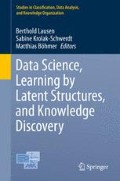Abstract
This paper presents a comparative study of classification performance in automatic audio chord recognition based on three chroma feature implementations, with the aim of distinguishing effects of frame size, instrumentation, and choice of chroma feature. Until recently, research in automatic chord recognition has focused on the development of complete systems. While results have remarkably improved, the understanding of the error sources remains lacking. In order to isolate sources of chord recognition error, we create a corpus of artificial instrument mixtures and investigate (a) the influence of different chroma frame sizes and (b) the impact of instrumentation and pitch height. We show that recognition performance is significantly affected not only by the method used, but also by the nature of the audio input. We compare these results to those obtained from a corpus of more than 200 real-world pop songs from The Beatles and other artists for the case in which chord boundaries are known in advance.
Access this chapter
Tax calculation will be finalised at checkout
Purchases are for personal use only
References
Anglade, A., Ramirez, R., & Dixon, S. (2009). Genre classification using harmony rules induced from automatic chord transcriptions. In Proceedings of the 10th International Conference on Music Information Retrieval (ISMIR) (pp. 669–674).
Baume, C. (2013). Evaluation of acoustic features for music emotion recognition. In Proceedings of Audio Engineering Society Convention 134.
Celma, O. (2010). Music recommendation and discovery. Berlin/Heidelberg: Springer.
Fujishima, T. (1999). Realtime chord recognition of musical sound: A system using common LISP music. In Proceedings of the International Computer Music Conference (ICMC) (pp. 464–467).
Gómez, E. (2006). Tonal description of music audio signals. PhD thesis, Department of Information and Communication Technologies, Universitat Pompeu Fabra, Barcelona.
Goto, M. (2003). A chorus-section detecting method for musical Audio signals. In Proceedings of the 2003 IEEE International Conference on Acoustics, Speech, and Signal Processing (ICASSP) (pp. 437–440).
Goto, M., Hasiguchi, H., Nishimura, T., & Oka, R. (2003). RWC music database: Music genre database and musical instrument sound database. In Proceedings of the 4th International Conference on Music Information Retrieval (ISMIR) (pp. 229–230).
Lartillot, O., & Toivainen, P. (2007). MIR in matlab (II): A toolbox for musical feature extraction from audio. In Proceedings of the 8th International Conference on Music Information Retrieval (ISMIR) (pp. 127–130).
Mattern, V., Vatolkin, I., & Rudolph, G. (2013). A case study about the effort to classify music intervals by chroma and spectrum analysis. In B. Lausen, D. Van den Poel, & A. Ultsch (Eds.), Algorithms from and for nature and life (pp. 519–528). Berlin/Heidelberg: Springer
Mauch, M. (2010). Automatic chord transcription from audio using computational models of musical context. PhD thesis, School of Electronic Engineering and Computer Science Queen Mary, University of London.
Mauch, M., & Dixon, S. (2010). Approximate note transcription for the improved identification of difficult chords. In Proceedings of the 11th International Society for Music Information Retrieval Conference (ISMIR) (pp. 135–140).
Mauch, M., Cannam, C., Davies, M., Dixon, S., Harte, C., Kolozali, S., Tidhar, D., & Sandler, M. (2009). OMRAS2 metadata project 2009. In Late-Breaking Session at the 10th International Conference on Music Information Retrieval (ISMIR).
Mierswa, I., Wurst, M., Klinkenberg, R., Scholz, M., & Euler, T. (2006) YALE: Rapid prototyping for complex data mining tasks. In Proceedings of the 12th ACM SIGKDD International Conference on Knowledge Discovery and Data Mining (KDD) (pp. 935–940).
Jiang, N., Grosche, P., Konz, V., & Müller, M. (2011). Analyzing chroma feature types for automated chord recognition. In Proceedings of the 42nd AES Conference (pp. 285–294).
Randel, D. M. (1999). The Harvard Concise Dictionary of Music and Musicians. Cambridge: Harvard University Press.
Sheh, A., & Ellis, D. P. W. (2003). Chord segmentation and recognition using EM-trained hidden markov models. In Proceedings of the 4th International Conference on Music Information Retrieval (ISMIR). (pp. 135–141).
Author information
Authors and Affiliations
Corresponding author
Editor information
Editors and Affiliations
Rights and permissions
Copyright information
© 2015 Springer-Verlag Berlin Heidelberg
About this paper
Cite this paper
Stoller, D., Mauch, M., Vatolkin, I., Weihs, C. (2015). Impact of Frame Size and Instrumentation on Chroma-Based Automatic Chord Recognition. In: Lausen, B., Krolak-Schwerdt, S., Böhmer, M. (eds) Data Science, Learning by Latent Structures, and Knowledge Discovery. Studies in Classification, Data Analysis, and Knowledge Organization. Springer, Berlin, Heidelberg. https://doi.org/10.1007/978-3-662-44983-7_36
Download citation
DOI: https://doi.org/10.1007/978-3-662-44983-7_36
Publisher Name: Springer, Berlin, Heidelberg
Print ISBN: 978-3-662-44982-0
Online ISBN: 978-3-662-44983-7
eBook Packages: Mathematics and StatisticsMathematics and Statistics (R0)

